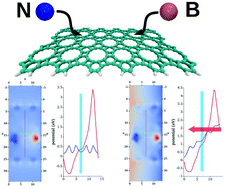Graphenylene-based nanoribbons for novel molecular electronic devices
Abstract
In the last decade, graphene has been frequently cited as one of the most promising materials for nanoelectronics. However, despite its outstanding mechanical and electronic properties, its use in the production of real nanoelectronic devices usually imposes some practical difficulties. This happens mainly due to the fact that, in its pristine form, graphene is a gapless material. We investigate theoretically the possibility of obtaining rectifying nanodevices using another carbon based two dimensional material, namely the graphenylene. This material has the advantage of being an intrinsic semiconductor, posing as a promising material for nanoelectronics. By doping graphenylene, one could obtain 2-dimensional p–n junctions, which can be useful for the construction of low dimensional electronic devices. We propose 2-dimensional diodes in which a clear rectification effect was demonstrated, with a conducting threshold of approximately 1.5 eV in direct bias and current blocking with opposite bias. During these investigations were found specific configurations that could result in devices with Zener-like behavior. Also, one unexpected effect was identified, which was the existence of transmission dips in electronic conductance plots. This result is discussed as a related feature to what was found in graphene nanoribbon systems under external magnetic fields, even though the external field was not a necessary ingredient to obtain such effect in the present case.



 Please wait while we load your content...
Please wait while we load your content...